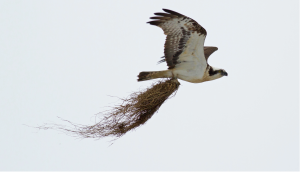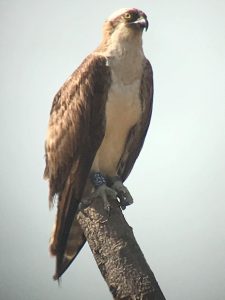The year 1996 was the beginning of an exciting translocation project, which aimed to reintroduce a breeding population of ospreys to central England. Between 1996 and 2001, 64 young ospreys were translocated from Scotland to Rutland, and a further 11 females were translocated in 2005, to try and redress the gender imbalance that had become apparent. A total of 75 osprey chicks were translocated – the majority of which were never seen again following their departure from Rutland in their first autumn. Despite the low percentage return rate, and the long years of waiting and hoping, those pioneering ospreys that did return and recognise Rutland Water as their ‘home’, laid the foundations of a now flourishing colony.

Male Osprey 03(97) aka “Mr Rutland” who raised 32 chicks
Every year since 2015, the Rutland area’s breeding population has been eight, nine, or (in the last two years) ten pairs, proving a prediction, foreseen by Roy Dennis in the early 1990s absolutely correct that the area could support between eight and ten pairs, and, perhaps, with still more expansion to come. In the last ten years, we have also seen a positive shift in the make-up of those breeding pairs. Whilst initially the pairs were, understandably, mostly comprised of translocated ospreys, this gradually changed to the pairs being formed of Rutland-born birds, with a few Scottish or unringed individuals as well, an indication of the success of the translocation project.
It is also fair to mention the Rutland ospreys are “spreading their wings” so to speak and are starting to influence osprey populations elsewhere in the UK and even abroad. Over the course of the past 25 years, five female ospreys, who are less site faithful than their male counterparts, have bred at Welsh nest sites. Having said that, one Rutland male S2(15), has gone much further than Wales and is occupying a nest in the Netherlands!

056, the 150th chick to fledge from Rutland, photographed by Chris Wood
Fast forward to today, and 2021 marks the Rutland Osprey Project’s 25th anniversary. And though over the years we have faced trials, tribulations and the whole spectrum of emotions, that have accompanied the Project, we are now able to celebrate the remarkable achievements made, as a conservation success story in its own right.
The initiative at Poole Harbour in Dorset of a second Osprey Project, using a similar model to Rutland’s, is exciting and fulfilling for everyone who has witnessed the return of these spectacular birds. The fact a female osprey, CJ7, hatched in Rutland, has taken up possession of a nest in the Poole area for the past few summers, is most encouraging. A returning male will one day soon take that first bold and crucial step and stay with her to begin the cycle again at this splendid new location. Since the first translocation to the area in 2017, 33 young ospreys have been released, and of course that number will probably double in the next three years. Hopes of a first breeding were raised when the first returning male, two year old LS7, stayed around with CJ7 for most of the summer of 2019, but, as is often the case, there was no progeny from this first encounter and LS7 did not re-appear in 2020. But the statistics suggest first breeding is not far away! In Rutland, nest-building was first observed in 2000, four years after the first translocation, with breeding occurring the following year, 2001. If these results are reciprocated in the Poole area, then 2021 and 2022 look set to be highly significant years!
As the Rutland Osprey Project reaches its 25th anniversary and is set to welcome its 200th chick at some point in 2021, we often look back and remember the early years, when such success seemed merely a dream. With the incredible dedication of staff, volunteers and landowners over the years, and the resilience of these amazing birds themselves, the dream has become reality. We cannot wait to work ever more closely with our friends and colleagues at Poole Harbour, and share one another’s successes, as we prepare to start scanning the skies again to welcome back the first ospreys of the year!
A better bank holiday Monday than anticipated with the early rain and cloud cover bringing with it a…
Find out moreThere was another Common Crane movement/arrival with a group of 3 heading down the Piddle Valley this afternoon…
Find out more© 2025 Birds of Poole Harbour Registered Charity No. 1152615